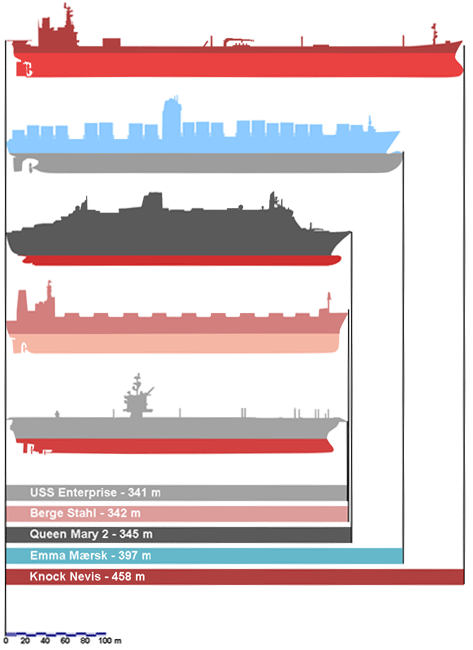|
| ||||||||||||||||||||||||||||||||||||||||||||||||
Emma Maersk is a container ship of the A.P. Moller-Maersk Group. When she was launched, Emma Maersk became the largest container ship ever built, and as of 2007 the longest ship in use. The largest ship ever built was the supertanker Knock Nevis, but now she serves as a floating storage and offloading unit (FSO). Emma Maersk is able to carry around 11,000 TEU in the calculation of the Maersk company which is about 1,400 more containers than any other ship is capable of carrying.
CapacityIn common calculation, her cargo capacity is much bigger - between 13,500 and 14,500 TEU. The difference between the official and estimated number results from the fact that Maersk calculates the cargo capacity of a container ship by using the number of containers with a weight of 14 tons that can be carried on a vessel. For the Emma Maersk, this is 11,000 containers. Other companies calculate the cargo capacity of a ship according to the maximum number of containers that can be put on the ship, independent of the weight of the containers. This number is always greater than the number calculated by the Maersk company. Engine and environmentThe Emma Maersk is powered by a Wartsila 14RT-Flex96c engine, currently the world's largest single diesel unit, weighing 2,300 tons and capable of 110,000 horsepower (82 MW). The ship has several features to protect the environment. This includes recycling the exhaust, mixed with fresh air, back into the engine for reuse. This not only increases efficiency by as much as 12% but also reduces engine emissions. Instead of biocides, used by much of the industry to keep barnacles off of the hull, a special silicone-based paint is used. This increases the ship's efficiency by reducing drag while also protecting the ocean from biocides that may leak. The silicone paint covering the part of the hull below the waterline is credited for lowering the water drag enough to economize 1200 tonnes of fuel per year.
| ||||||||||||||||||||||||||||||||||||||||||||||||

Maersk Line is one of the leading liner shipping companies in the world, serving customers all over the globe.
| ||||||||||||||||||||||||||||||||||||||||||||||||
|
EMMA MAERSK Container vessel -
Schedules |
Specification |
Engine |
Photo gallery |
Shipping Lines Directory |
Freight Directory
| ||||||||||||||||||||||||||||||||||||||||||||||||



